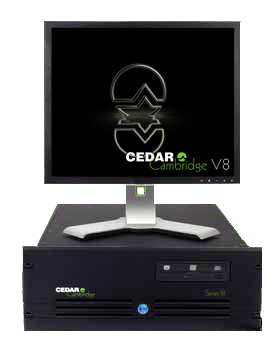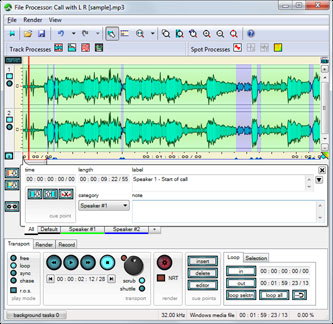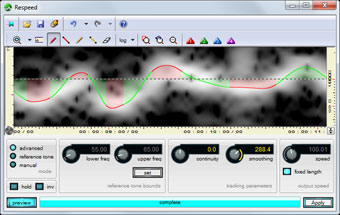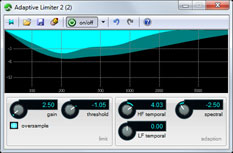Announcing CEDAR Cambridge V8

-- now with video playback and more --
PRODUCT ANNOUNCEMENT: 18 Jun 2012
CEDAR Cambridge V8 is the latest revision of the acclaimed CEDAR Cambridge system, and boasts numerous upgrades and improvements over previous versions.
Most obviously, CEDAR Cambridge now supports video playback, allowing you to view the visual content of up to eight A/V files simultaneously while analysing and processing the audio contained within them.
At the architectural level, it boasts an expanded file processing system, with powerful new region categories that hugely enhance its ability to perform independent processing on multiple regions of the audio and greatly extend its transcription capabilities. The system also offers improved output mapping, an expanded Hot Keys section, and it has been upgraded to play, record and process at 192kHz.
Alongside this, it offers numerous updates within its restoration and other processing modules, such as new tools in the enhanced Retouch 5™ and Respeed™, the addition of the ITU1770-2 and M-weighted standards in the Power Normaliser, and a revised Adaptive Limiter™ that greatly extends the range of limiting and maximising effects obtainable.
With numerous other improvements, CEDAR Cambridge V8 remains the system of choice for remastering studios, archives, sound libraries and audio forensic investigation.
System upgrades
 Not only can you define multiple regions within an audio file, you are now able to allocate these to multiple user-defined categories to differentiate (for example) between multiple microphones or scenes in a soundtrack, between the various speakers in a conversation, or between speakers recorded during the course of a telephone call. Region categories are therefore a huge aid in the performance of transcription, especially when used in conjunction with the Report Generator.
Not only can you define multiple regions within an audio file, you are now able to allocate these to multiple user-defined categories to differentiate (for example) between multiple microphones or scenes in a soundtrack, between the various speakers in a conversation, or between speakers recorded during the course of a telephone call. Region categories are therefore a huge aid in the performance of transcription, especially when used in conjunction with the Report Generator.
Other updates include a combined waveform/spectrogram view that shows both simultaneously to speed up the identification of audio events, and an increase in the maximum sample rate to 192kHz. In addition, there's a MIDI Note scale to augment the standard frequency axes, harmonic markers to aid the use of modules such as debuzz and the EQs, improved rendering and looping, and greater efficiency when handling large numbers of edits in modules such as Retouch 5.
Most noticeably, the video playback system allows users to extract and process the audio content from a range of A/V formats and view the visual content in a separate window while processing. Multiple files can be handled up to a maximum of eight audio tracks, and the required number of video windows will be created automatically.
 Retouch 5™
Retouch 5™
Boasting numerous improvements, Retouch 5 introduces Previewing and a new Volume mode, which allow users to process - and listen exclusively to - selected areas of the spectrogram. There's also a new Pitch Shifter in the Patch and Copy modes. This invokes a genuine pitch shift algorithm that takes into account the relative pitch of components within the audio selection, greatly aiding the correction of errors in harmonically rich material. There's also a new paintbrush mode, and this allows you to pinpoint problems or draw broad sweeps to identify complex sounds such as aircraft flying overhead, or birdsong. Used together with the new MIDI Note scale, these tools even allow you to correct the pitches of incorrect notes within musical material.
 Respeed™
Respeed™
With two powerful new functions - Hold and Invert - Respeed is now capable of creating a speed correction template using one audio file and applying it to another. Amongst other things, this allows users to correct the speed of multi-track material held in separate files before mixing. The new version is also able to invert a template and reapply it, which makes it possible to correct unusual problems such as wandering tones before returning the audio to its original state.
 Adaptive Limiter 2
Adaptive Limiter 2
In response to feedback from our customers, we have enhanced the Adaptive Limiter, making it possible to apply even more limiting while retaining the integrity of the original audio. Not just a limiter, it's fair to say that the Adaptive Limiter is now an extremely flexible maximiser too, capable of pushing your audio far further than before without introducing unpleasant artefacts.
 Power Normaliser 2
Power Normaliser 2
Featuring two further loudness standards, the Power Normaliser is now even more flexible for broadcast and cinematic production.
ITU1770-2 uses a 'gated loudness' approach that omits quiet passages (such as the gaps between utterances) from the gain calculations, making it particularly suitable for speech. In addition to this, there's now an M-weighted calculation, the standard being adopted by the film industry to assess audio loudness when listening at cinema playback levels.
Putting it all together
CEDAR Cambridge V8 is immediately available and runs on legacy CEDAR Cambridge Q systems as well as the latest CEDAR Cambridge Series III hardware running Windows 7 Ultimate 64-bit. Users are advised to upgrade to the latest specification to take advantage of all the new features.
As always, software upgrades to both the core system and to existing modules are provided free of additional charge to existing users. A full set of OS and hardware upgrade options are also offered.
For further information about CEDAR's latest developments, contact:
CEDAR Audio Ltd
20 Home End, Fulbourn, Cambridge CB21 5BS, UK
Tel: +44 1223 881771 · Fax: +44 1223 881778 · Email: info@cedaraudio.com